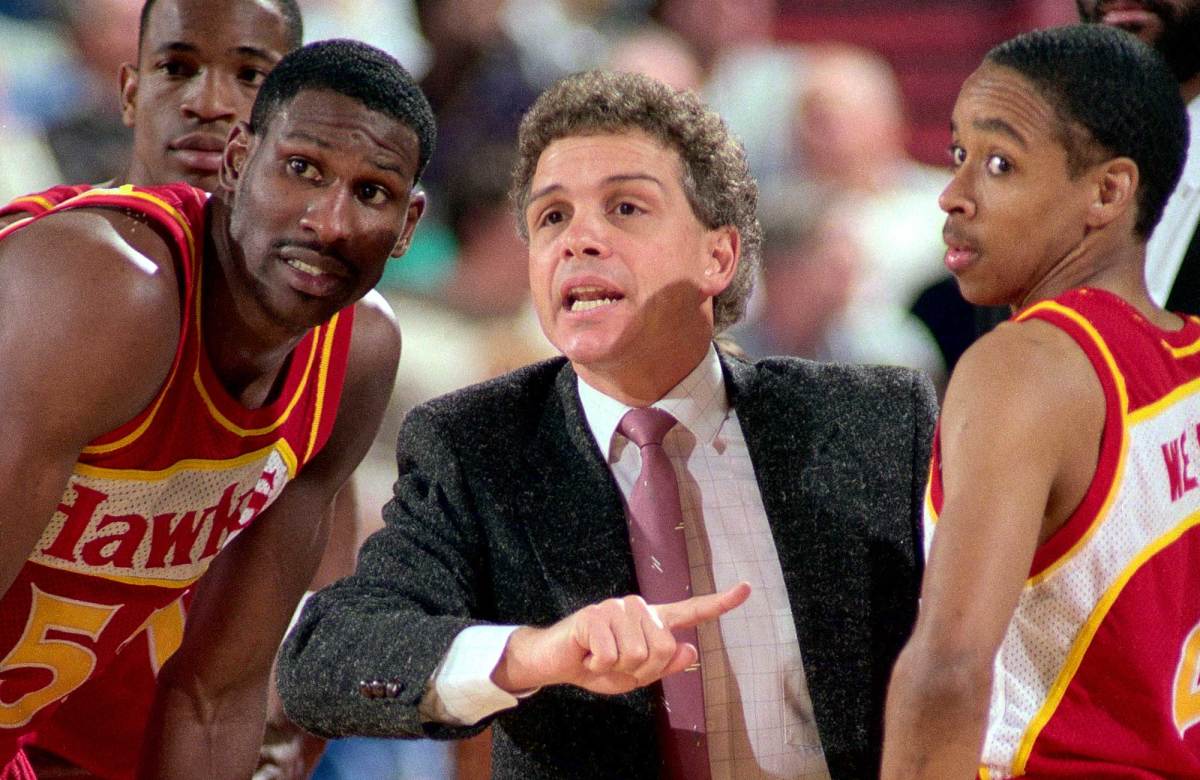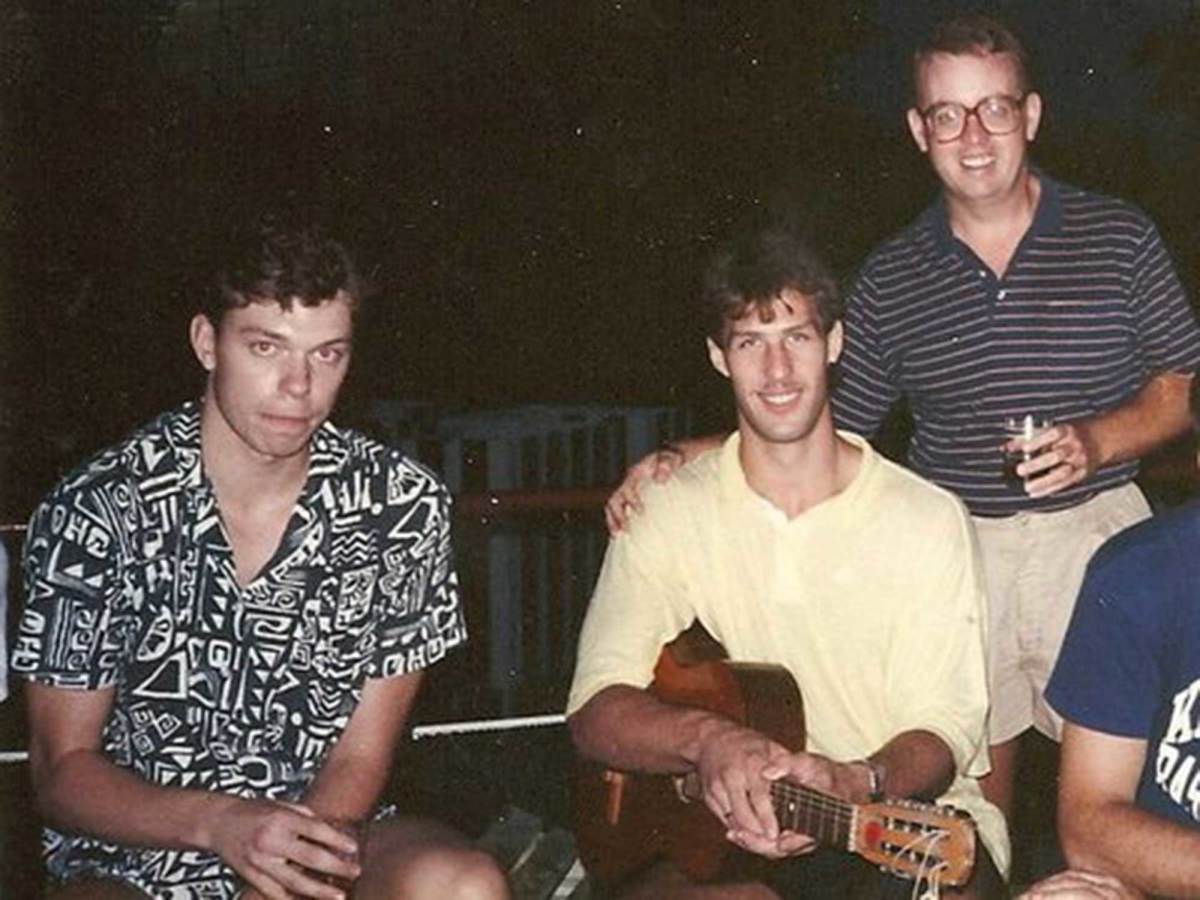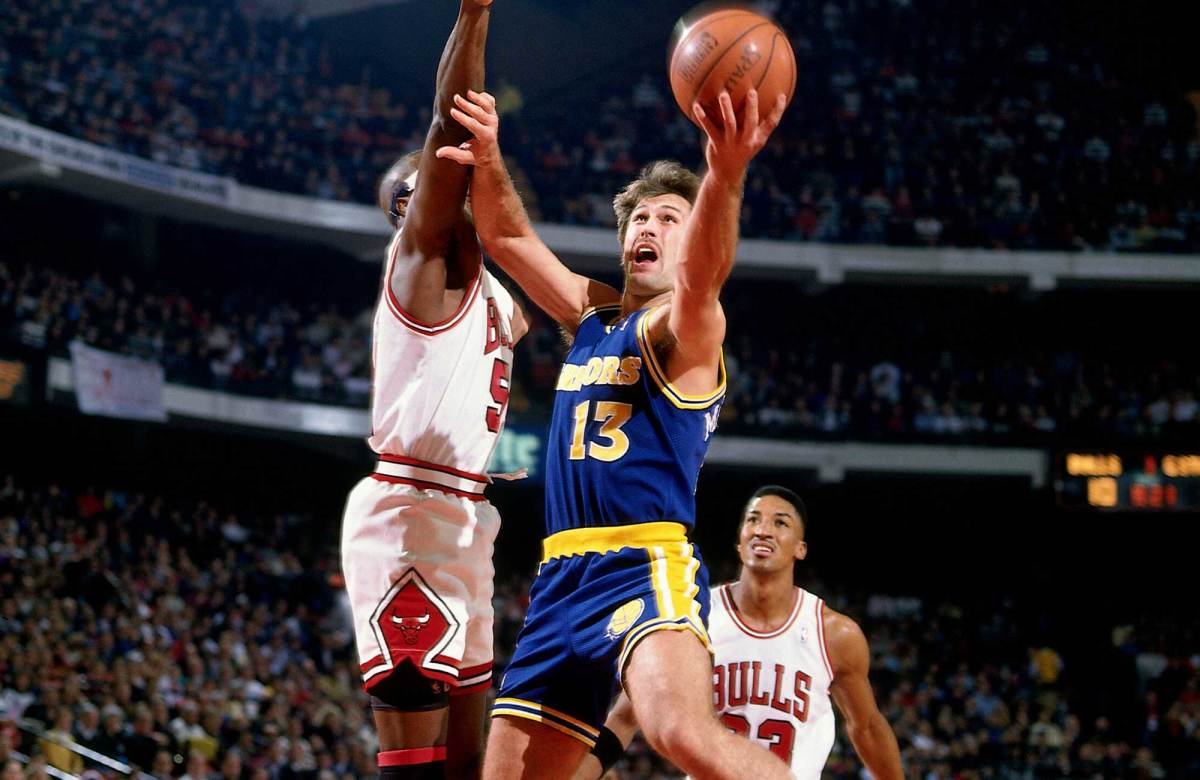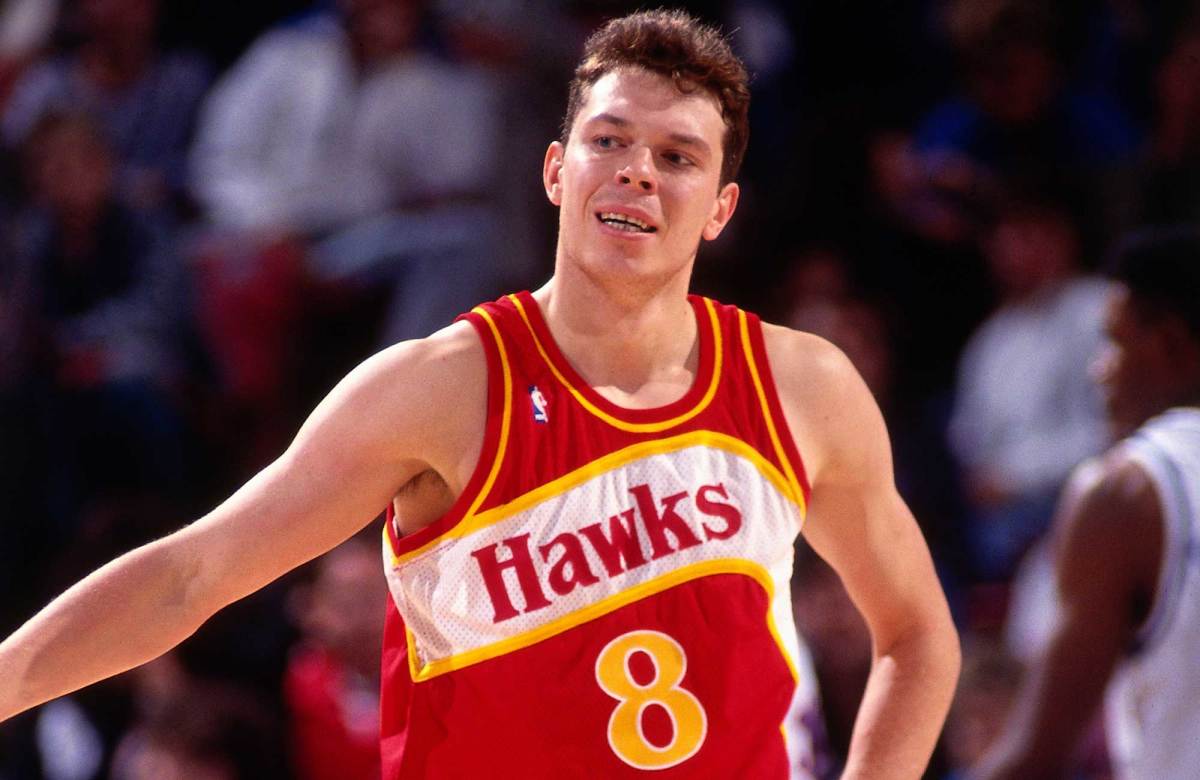'Many Shoot, Few Make': Inside the NBA's First Journey to Russia

Mike Fratello wasn't the Czar of the Telestrator yet when he stood alongside his players outside a desolate Georgian air terminal. Even in the Soviet Union, he was not the czar of anything. He was the head coach of the Atlanta Hawks, but the team’s de facto ruler was Ted Turner, who was the reason they were here in the other Georgia in the first place. The year was 1988, and Fratello just needed his team’s luggage. The Hawks had just landed in Sukhumi alongside the Soviet national team for a two-week exhibition tour, their mission diplomatic but abstract. It didn’t take long to notice everyone’s bags sitting alone on the airstrip, exactly where the plane had left them. Fratello commandeered a nearby truck, took a handful of players and went to retrieve their things. As one might have portended, this was not the NBA.
On July 25, 1988, 29 years ago to the day, the Hawks became the first NBA team ever to play a game in the USSR, with the first of three games against the Soviets taking place in Tbilisi, the Georgian capital. It was a “breakthrough type of situation,” as Fratello puts it now. At the behest of team owner and television mogul Turner and in conjunction with David Stern and the NBA, the Hawks had flown over for the hoops tour. Publicly, the aim was to spread the game and bridge the gap as Cold War tensions began to cool. Communist party leader Mikhail Gorbachev’s policies of perestroika (restructuring) and glasnost (openness) signaled a massive shift in ideology and economy that eventually led to the dissolution of the Soviet government. The Soviet team pulled the best players from across the union’s republics, dominated international play and would make the games interesting. Gorbachev’s relationship with Turner enabled a trip that would irrevocably alter the NBA for the better.
For those on the ground the concept was novel, and there was little sense of what it would eventually mean. The teams had flown together in a massive IL-86 jet from Moscow to Sukhumi (pronounced Soo-khoo-mee) for what the Hawks were told was an Olympic training camp situated on the Black Sea. They’d tip off the tour with the exhibition in Tbilisi, play another in the Lithuanian capital of Vilnius, and wrap up with a third game in Moscow. Other than that—and retrieving their baggage themselves—the Hawks and their traveling party had little idea what would come next.

The flight was supposed to have been a charter. Instead, it carried a mixture of civilians and live animals, and included no amenities. Water from a shared wooden drinking bowl proved the closest thing to a free refill. The bus ride from the airport to the training base was interrupted at length by cattle parked squarely in the middle of a narrow dirt access road. The main thing about Sukhumi was, it wasn’t a beach resort and you didn’t want to go there. “The only thing they didn't tell us was that [the facility] probably had been closed down for a few years,” says Fratello. “They kind of left that out.”
The American contingent included players, team staffers, media, friends and family. Some brought brochures for scuba diving and equipment for horse riding, amusing their hosts. “I quietly tried to explain what kind of place we are going. They had no idea,” remembers Alexander Volkov, then a 24-year-old forward for the Soviet team. The facility was functional at best, with no air conditioning in near-tropical heat, sparse dining, freezing showers and next to no amenities, plus a serious mosquito problem. This came as no shock to Volkov and his teammates, who had practiced together for years around the Soviet Union in varying conditions. The Sukhumi site lay in a disputed ethnic region and would later fall directly on the front lines of the Abkhaz-Georgian conflict. The USSR remained a military power, but was far from a modern one in terms of living standards.
“I look back on it fondly now, but at the time, what we did for two weeks was we basically ate cucumbers, tomatoes and warm vodka,” says longtime Hawks radio voice Steve Holman, who Fratello would later declare the “historian of the trip.” Over the course of three nights in Sukhumi, the group bonded over Kool Moe Dee and bartered with those with the foresight to bring their own snacks. The electricity and phone lines came and went. Hawks guard Doc Rivers and Soviet star Sarunas Marciulionis (armed with his guitar and some Lithuanian folk songs) helped set the tone for an amicable relationship between the teams. Circumstances aside, the Americans were put at ease.

“You’re going into an unknown situation a long ways away that depending on what story you want to read, who you want to believe, that's not an area we were familiar with, the politics of what was going on between the United States and the Soviet Union,” says Fratello. “Were we on good terms? Were we on bad terms? What’s the truth? We don’t know. So yeah, there was some concern about what we were getting ourselves into.”
“I didn't even want to go,” says Kevin Willis, who missed the Sukhumi leg and met up in Vilnius, along with Dominique Wilkins, the team’s star player. “[Ted] Turner was like 'Man, get up on this airplane,' so I had to. It was just one of those things, we didn't know what was going to take place.” Though many Hawks had mixed feelings about being there in the first place, the humor was lost on few. “Had there been an internet, I would have written a blog post every day,” says longtime Sports Illustrated writer Jack McCallum, who was one of three journalists on the trip and recalls the series of events fondly. “That would have been some of the best material I would ever have.”
As with any group of American envoys at the time, there was implicit diplomacy at play. The actual motivations behind the trip were manifold. Turner masterminded the inaugural 1986 Goodwill Games in Moscow in response to the U.S. and Soviet Union boycotting the ’80 and ’84 Olympics, respectively. Of course, competition between the nations could be found on TBS. “Ted was on the mission of trying to make friends with people,” says Fratello, who’d helped broadcast the games and now works an analyst for Turner Sports, earning the “Czar” nickname over the course of a long television career. The games opened the door for the 1987 McDonald’s Open in Milwaukee, a three-team exhibition series between the Bucks, the Soviet Union and Italian club Tracer Milano. The familiarity bred enough trust to get the Hawks overseas, where Turner’s relationship with Gorbachev proved an advantageous vehicle for all.
“The trip was seen as a Ted Turner extravaganza,” says McCallum. NBA commissioner David Stern and TBS exec Bob Wussler, the founder of CNN, held meetings with top officials from Goskomsport, the Soviet sports federation. The NBA had designs on international inclusion, the Soviet team was prepping for the upcoming Olympics in Seoul, and discussions included broadcast rights and the like.
Derrick Rose Is the Cavaliers’ Latest Low-Impact Signing
“The league approved this because it was really the beginning of David Stern looking at the globality of the NBA. One of the first steps had to be players from Eastern Europe,” says Kim Bohuny, who helped run the trip for TBS and is now the NBA’s vice president of international basketball operations. Bohuny had been in charge of research and athlete profiles at the Goodwill Games and was already familiar with the Soviet players. “There were so many great players behind the Eastern European wall, and part of this was to bring it down for the NBA.”
Led by future Hall of Fame coach Alexander Gomelsky, the USSR drew from a massive pool of talent. They’d taken myriad trips over the years to play college teams in the United States. The Soviets featured Lithuanian center Arvydas Sabonis, considered the best big man in the world outside the NBA. He was also technically the property of the Portland Trail Blazers. The main reason the Hawks and president Stan Kasten were on the trip became a poorly kept secret: the team intended to recruit Marciulionis and Volkov, young Soviet standouts who later became European pioneers for the league.
Atlanta was ahead of the curve when it came to international scouting. In 1970, they made Mexico’s Manuel Raga and Italy’s Dino Meneghin the league’s first international draftees (they would never play an NBA game). The Hawks had taken Volkov, a Ukrainian forward, in the sixth round of the ’86 draft. They were also pursuing burly Lithuanian guard Marciulionis, also 24 years old, who unbeknownst to them had already forged a close relationship with Donnie Nelson that eventually led him to the Golden State Warriors. Neither player was a secret to scouts, both loved to attack the basket, and like many of their teammates bucked the European stereotypes with their toughness.

The Hawks were also the first team to draft Sabonis, taking him in the fourth round of the 1985 draft at age 20. The front office thought it'd exposed a loophole and gotten a steal. It had not. The league would officially deem Sabonis ineligible because he was under 21, and though Atlanta fought to keep his rights, he would return to the draft pool and become the Blazers’ first-round pick a year later. The debacle led to the implementation of a league rule most easily recognized today as “draft-and-stash,” allowing teams to hold onto players’ rights until they sign their first NBA contracts. It was too late for the Hawks, but the change stuck. Although it had always been clear that the Soviets were unwilling to let their players turn pro elsewhere, it didn’t deter the Hawks, who hoped Turner’s relationship with the government would give them a competitive advantage during Perestroika times.
Meanwhile, the Soviet players were happily living a pipe dream. A younger group including Marciulionis and Volkov had gone to play and train with the Hawks against semi-pro teams in the summer of ’87, but the thought of an NBA team coming to Soviet soil was on another level. “Coach Gomelsky told us a few months earlier, ‘You know guys, Atlanta Hawks coming to Soviet Union, we going to have training camp together and then some games,’” Volkov recalls. ”And we said, ‘Yeah, right, uh-huh. Atlanta Hawks coming to Soviet Union. We’re laughing and laughing, kidding to each other. But you know, time passes, it's closer to the summer, and then we see…it really looks like the Atlanta Hawks are coming.”
“Soviet Union was still Soviet Union at that time, Gorbachev, Perestroika, all these things, but still Soviet Union,” Volkov adds. “We couldn’t believe it had finally happened. We were so excited.” The Soviet team had an eye on the Olympics and would go on to win gold, upsetting a stacked team of American college players led by David Robinson in the semifinal. The prospect of playing in the NBA was still wishful thinking, and many players didn’t think they could compete in the first place. The American coaching and challenge of firsthand competition with the Hawks provided a mental edge, one which U.S. coach John Thompson would famously bemoan after losing to the Soviets a couple months later.
The Soviet players had been tested by Americans in the summers, but an NBA team fresh off the Eastern Conference semis was a different beast. The NBA wasn’t televised in the Soviet Union. Sergei Tarakanov, one of the team’s veterans, had relied on friends to supply him with bootleg game tapes over the years. This made for a pretty flimsy scouting report, but added emotional weight to the whole thing. “It’s like you watch a movie, and then finally see the actor face to face,” Tarakanov says.
Little did he know at the time, facing actors wasn’t the furthest thing from the truth. The Hawks players, with prior commitments and varying levels of interest, arrived in the USSR in two waves. Accordingly, ringers traveling with the team were required to dress, round out the roster and occasionally play. The faux-Hawks included Antoine Carr’s brother and Cliff Levingston’s roommate. Soviet players expected their opponents to be cocky given the circumstances, but were greeted warmly. Pre-conceived notions were tested and friendships were forged. “I think [especially] Marciulonis and Volkov, they wanted an openness, to show that we were one world,” says McCallum. The players grew to enjoy each other’s company, language barrier aside.

“We had a day off, and some American players came to me and said, Sasha, we want to go to club,” Volkov remembers. “I said, ‘OK, I think you realize, Sukhumi…what kind of club we have?” He was sure there were no local nightclubs, particularly with proximity to an isolated Soviet base, but called friends and checked anyway. “In a couple hours, KGB officer come to me and say ‘Sasha, please don't do stupid things.’ Of course, I played the fool. He told me, ‘Tell them it's a religious celebration and everything closed.’” No players left the base that night.
From there, the teams broke camp and headed to Tbilisi. Accommodations were better, practices were well-attended, fans clamored for a glimpse of the players, and 10,000 people watched the Hawks win 85–84, on July 25. Zaza Pachulia’s mother was among the spectators. Dominique Wilkins missed the game after flying in solo, and missing his connection in Moscow, where he was stranded for 12 hours. While waiting for Wilkins, the rest of the traveling party toured a sweltering mine, riding an elevator deep into the earth and returning topside massively relieved. “They thought it was a great tourist thing to do,” says McCallum. “I was there with Mike Fratello, we were sinking into this mine, it's a terrible smell on the elevator. Mike said, ‘Wow, I bet Dominique’s really pissed he’s missing this.’”
Next was Vilnius, the basketball-crazed Lithuanian capital. With a weary Wilkins in uniform and a young Zydrunas Ilgauskas watching from the stands, Atlanta won 110–105 in overtime. Although the Hawks were depleted, exhausted and out of their element, the games were close enough that they still meant something. The Soviets were known for their conditioning and were never outworked. “They were extremely talented, strong, very disciplined, never let up and kept coming at you,” says Willis.
The final stop on the tour was Moscow. Some Hawks players viewed two of three as winning the series, which in hindsight suggested a letdown. While there, Fratello, who frequently took the Hawks out for Italian meals on the road and fancied himself a chef, cooked a massive spaghetti dinner for the teams. Ingredients were flown in courtesy of the league, and generous portions were doled out by David Stern. “Everyone said we were eating like we were going to the electric chair that night,” Holman says.
Back on the court, the Hawks were lackadaisical and the Soviets finally got them, winning 132–123 in a game that was broadcast across the United States on TBS. Volkov scored 35, Marciulionis added 23, and Atlanta played, as McCallum would put it in the pages of Sports Illustrated, “like a club in a hurry to get home.” Gomelsky also summed up the game nicely afterward. “I’m asking about how bad the play was,” McCallum remembers. “[Gomelsky] shrugs, and goes, ‘Many shoot, few make.’ I've since used that one a lot.”
Everyone involved remembers those two weeks fondly, and all acknowledge their lasting impact. “It was a brilliant opportunity, and we had to be thankful for those guys who were brave enough to open those curtains," Marciulionis says. “We didn't know and they didn't know [then] how much that helped to open up doors for Europeans.” The trip stands today as a tangible step toward Soviet athletes competing professionally in the West. Many players had quietly come to seek independence for not only their countries, but themselves. “At the Olympics, we were a little bit challenging Gomelsky,” Marciulionis explains. “Like, OK, if we win, if he [would] to help us play outside the Soviet Union, that was the conversation that was on our mind. But it wasn’t necessarily with the goal to play in the NBA.”
The Soviets won gold in Seoul that September, and Marciulionis and Volkov were permitted by their governments to play stateside in ’89, the former joining the Warriors and the latter the Hawks at long last. Eight months after the gold–medal upset, NBA players were permitted to play in international competition. Any direct correlation between the Soviet victory and American stars playing in the ‘92 Olympics is mostly mythical—after all, the rules were nearly changed in 1986. Even the NBA was initially unenthusiastic at the thought of international play, as detailed in McCallum’s essential account, Dream Team, though the worldwide interest in hoops spawned by American pros on a global stage was inarguable.
The Berlin Wall fell in 1989, the USSR dissolved in ’91, and Lithuania, Estonia and Latvia became officially recognized athletic federations going into the Barcelona Games. Thanks to creative fundraising efforts that famously involved band members from the Grateful Dead, Marciulionis, Sabonis and others could star for their home country at long last. In a historic game, Lithuania won bronze against what was known as the ‘Unified Team,’ consisting of players from the other former Soviet republics. Many, Volkov among them, were their former teammates. Flagship Russian club CSKA Moscow brought over its first American imports in ’94. Sabonis finally came to Portland in ’95, albeit on the back end of an injury-plagued career. Others turned down their chances to head west, but the floodgates were open. In the years that followed, a swath of players from the former USSR would make their way to the NBA.
At the beginning of the 2016–17 season, season, 113 players from 41 countries and territories were on NBA rosters. Eastern Europe had a heavy presence, with nine players hailing from countries once encompassed by the former Soviet Union and 14 more from countries once part of Yugoslavia. Russia won European gold in ’07 with David Blatt as coach and Andrei Kirilenko (now the federation’s commissioner) as the team’s anchor. Of course, Kristaps Porzingis is from Latvia. Lithuania’s active players include Jonas Valanciunas and Sabonis’s youngest son Domantas. What was once far-fetched has become possible for prospective players all over the globe.
“You know, we kind of dreamed about [the NBA], but I did not tell people, tried not to look stupid,” says Volkov. “With situation in the world, with Soviet Union, all these things happening…inside, I thought yes, it seemed like there was a chance.” Nobody would have bet on it at the time, but that same attitude would empower a generation of players.
“I'm thinking, I’m 25. If I cannot make it now, no way can I make it later. Maybe I will not succeed, but better for me to stay in Europe, not come to NBA, than to think I had a chance and didn't come.”
